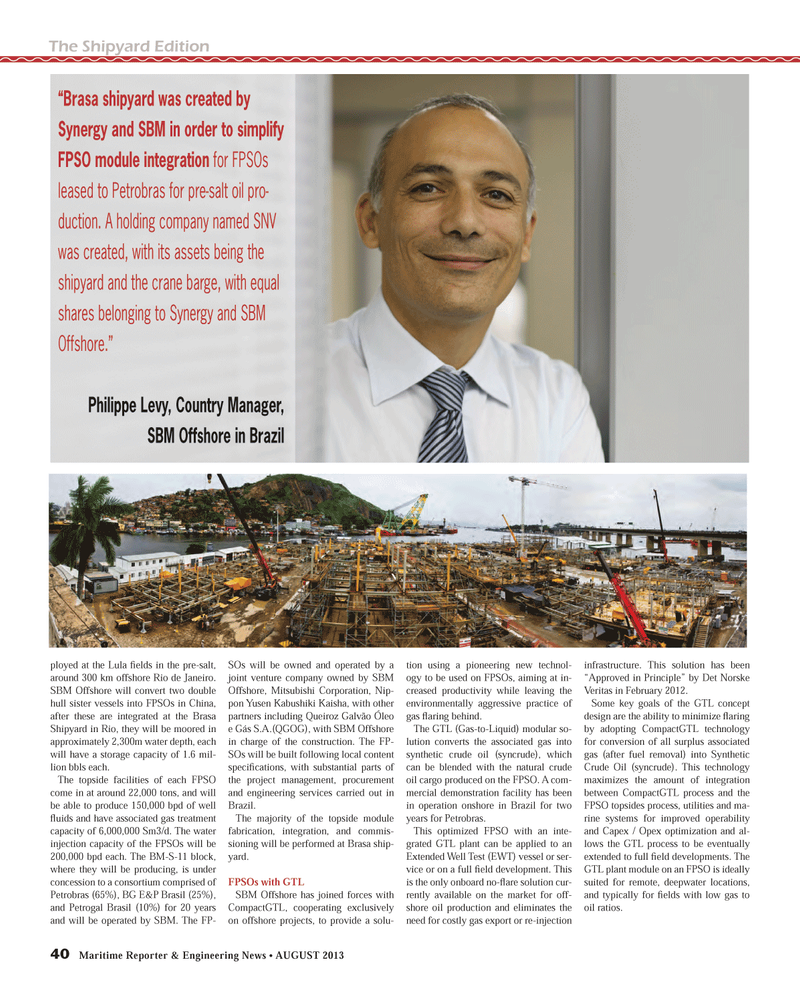
Page 40: of Maritime Reporter Magazine (August 2013)
Shipyard Edition
Read this page in Pdf, Flash or Html5 edition of August 2013 Maritime Reporter Magazine
40 Maritime Reporter & Engineering News ? AUGUST 2013 ployed at the Lula Þ elds in the pre-salt, around 300 km offshore Rio de Janeiro. SBM Offshore will convert two double hull sister vessels into FPSOs in China, after these are integrated at the Brasa Shipyard in Rio, they will be moored in approximately 2,300m water depth, each will have a storage capacity of 1.6 mil-lion bbls each. The topside facilities of each FPSO come in at around 22,000 tons, and will be able to produce 150,000 bpd of well ß uids and have associated gas treatment capacity of 6,000,000 Sm3/d. The water injection capacity of the FPSOs will be 200,000 bpd each. The BM-S-11 block, where they will be producing, is under concession to a consortium comprised of Petrobras (65%), BG E&P Brasil (25%), and Petrogal Brasil (10%) for 20 years and will be operated by SBM. The FP- SOs will be owned and operated by a joint venture company owned by SBM Offshore, Mitsubishi Corporation, Nip- pon Yusen Kabushiki Kaisha, with other partners including Queiroz Galvão Óleo e Gás S.A.(QGOG), with SBM Offshore in charge of the construction. The FP- SOs will be built following local content speciÞ cations, with substantial parts of the project management, procurement and engineering services carried out in Brazil. The majority of the topside module fabrication, integration, and commis-sioning will be performed at Brasa ship-yard. FPSOs with GTLSBM Offshore has joined forces with CompactGTL, cooperating exclusively on offshore projects, to provide a solu-tion using a pioneering new technol-ogy to be used on FPSOs, aiming at in-creased productivity while leaving the environmentally aggressive practice of gas ß aring behind. The GTL (Gas-to-Liquid) modular so- lution converts the associated gas into synthetic crude oil (syncrude), which can be blended with the natural crude oil cargo produced on the FPSO. A com- mercial demonstration facility has been in operation onshore in Brazil for two years for Petrobras. This optimized FPSO with an inte-grated GTL plant can be applied to an Extended Well Test (EWT) vessel or ser- vice or on a full Þ eld development. This is the only onboard no-ß are solution cur- rently available on the market for off- shore oil production and eliminates the need for costly gas export or re-injection infrastructure. This solution has been ?Approved in Principle? by Det Norske Veritas in February 2012. Some key goals of the GTL concept design are the ability to minimize ß aring by adopting CompactGTL technology for conversion of all surplus associated gas (after fuel removal) into Synthetic Crude Oil (syncrude). This technology maximizes the amount of integration between CompactGTL process and the FPSO topsides process, utilities and ma-rine systems for improved operability and Capex / Opex optimization and al-lows the GTL process to be eventually extended to full Þ eld developments. The GTL plant module on an FPSO is ideally suited for remote, deepwater locations, and typically for Þ elds with low gas to oil ratios. The Shipyard Edition?Brasa shipyard was created by Synergy and SBM in order to simplify FPSO module integration for FPSOs leased to Petrobras for pre-salt oil pro- duction. A holding company named SNV was created, with its assets being the shipyard and the crane barge, with equal shares belonging to Synergy and SBM Offshore.? Philippe Levy, Country Manager, SBM Offshore in Brazil MR #8 (34-41).indd 40MR #8 (34-41).indd 408/1/2013 9:41:15 AM8/1/2013 9:41:15 AM

 39
39

 41
41
